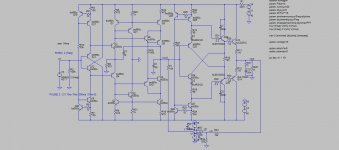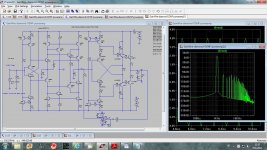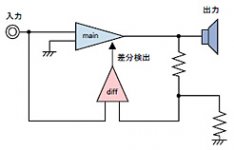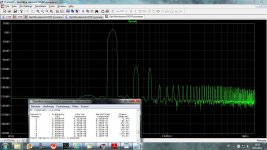This is no GNFB amp, the gain part is a current conveyor and output stage use Only Distortion Negative Feedback (ODNF).
The gain is set by the P1/R9 ratio.
Distortion was lowered at 1 kHz with ODNF from 0.036191% to 0.000323% (40dB) and at 20 kHz from 0.037325% to 0.006647% (15dB). I am not sure what is the reason for that low improvement at 20 kHz, could be the OP amp used in ODNF or I do something wrong here. Comments and suggestion welcome.
The gain is set by the P1/R9 ratio.
Distortion was lowered at 1 kHz with ODNF from 0.036191% to 0.000323% (40dB) and at 20 kHz from 0.037325% to 0.006647% (15dB). I am not sure what is the reason for that low improvement at 20 kHz, could be the OP amp used in ODNF or I do something wrong here. Comments and suggestion welcome.
Attachments
In LTspice at least the choice of op amp can have a massive affect. Try LT1128.
Simple changing from LT1056 to LT1128 I've got oscilation, so simple swap does nor work, need more simulation.
Try putting a cap across the opamp from output to inverting input. Start at something stupidly high like 1n.
This is based on what I have found using a similar system in a global feedback amp. Remember, it is a feedback loop and may need some compensation.
With 5 pF it still have small oscilation, with 7 pF is table and distortion at 20kHz drops fro 0.037325% to 0.003628% and that is 20 dB still to little.
Try reducing P1 in value.
Also, watch out for capacitive loads on the output.
Have a read of this... this is for global feedback amps but may still be of use.
http://http://hifisonix.com/error-correction/
Also, watch out for capacitive loads on the output.
Have a read of this... this is for global feedback amps but may still be of use.
http://http://hifisonix.com/error-correction/
Hi Guys
Is there the opportunity to use opamps other than LT? I think their library is the problem.
Your implementation of ODNFB is interesting. Do you have a sim for just the section enclosed by ODNFB? This would let you know how much THD is from that section and how much from the input section.
Luxman runs the output stage openloop and compensates for the voltage gain stage errors (using ODNFB), so different from what you are doing.
Have fun
Kevin O'Connor
Is there the opportunity to use opamps other than LT? I think their library is the problem.
Your implementation of ODNFB is interesting. Do you have a sim for just the section enclosed by ODNFB? This would let you know how much THD is from that section and how much from the input section.
Luxman runs the output stage openloop and compensates for the voltage gain stage errors (using ODNFB), so different from what you are doing.
Have fun
Kevin O'Connor
Try reducing P1 in value.
Also, watch out for capacitive loads on the output.
Have a read of this... this is for global feedback amps but may still be of use.
http://http://hifisonix.com/error-correction/
If I reduce P1 I have to reduce R9 too as the ration P1/R9 defines the gain, and in this case distortion of the gain stage is going up.
Thanks for the link, yes I follow Bonsai nice amps designs and build.
Hi Guys
Is there the opportunity to use opamps other than LT? I think their library is the problem.
Your implementation of ODNFB is interesting. Do you have a sim for just the section enclosed by ODNFB? This would let you know how much THD is from that section and how much from the input section.
Luxman runs the output stage openloop and compensates for the voltage gain stage errors (using ODNFB), so different from what you are doing.
Have fun
Kevin O'Connor
Hi Struth,
Yes I simulated separately the gain stage and output stage. The gain stage has very low distortion in whole audio band, almost all distortion was generated in the output stage, that's why ODNF was used on output stage.
BR Damir
Hi Guys
Is there the opportunity to use opamps other than LT? I think their library is the problem.
Yes, but adding other op amp models is far from easy / obvious. I'm struggling to add the lm4562 to LTspice. Can add simple models (sub circuits) eg diodes and FETs but so far op amps have eluded me.
This is no GNFB amp, the gain part is a current conveyor and output stage use Only Distortion Negative Feedback (ODNF).
The gain is set by the P1/R9 ratio.
Distortion was lowered at 1 kHz with ODNF from 0.036191% to 0.000323% (40dB) and at 20 kHz from 0.037325% to 0.006647% (15dB). I am not sure what is the reason for that low improvement at 20 kHz, could be the OP amp used in ODNF or I do something wrong here. Comments and suggestion welcome.
Damir, you seem dissapointed, those are very good numbers for a amp that doesnt use GNFB. Look around and try find some that can even come close to that. There simply is none.
The choice of opamp is important and Id use one with much higher performance that the LT. The reduced improvement at high frequency is simply the lower loop gain of the opamp resulting in the opamp less able to correct errors.
Nevertheless good result.
Hi Guys
Luxman runs the output stage openloop and compensates for the voltage gain stage errors (using ODNFB), so different from what you are doing.
Have fun
Kevin O'Connor
You are sure about this ??
Why would they bother with the voltage gain stage which has negible THD but the distortion is predominant in the outputstage. Sorry it doesnt make sense.
I dont think you ve understood the concept yet. See below.
Attachments
Damir, you seem dissapointed, those are very good numbers for a amp that doesnt use GNFB. Look around and try find some that can even come close to that. There simply is none.
The choice of opamp is important and Id use one with much higher performance that the LT. The reduced improvement at high frequency is simply the lower loop gain of the opamp resulting in the opamp less able to correct errors.
Nevertheless good result.
Thanks Manso, yes I understand important of opamp and I tried to use one from TI (the same as in the papers) but as mcd00uk said could not import yet to the LTspice.
BR Damir
Just looked through some Luxman brochures, the THD figures is in line with their claimed figures. Luxman use discrete opamp though but I dont think it is necessary. This range of amps from them cost 10 000 $ up.
Most opamp models are terrible, maybe Scott Wurcer could provide some good ones from their range of opamps.
Most opamp models are terrible, maybe Scott Wurcer could provide some good ones from their range of opamps.
An japanese diyer Shinich Kamijo(deceased) explained,
ODNF differs from HEC or ZDR ,which can theoretically cancel out entire distortion,
ODNF cannot cancel the distortion entirely.
The amount of improvement depends on the loopgain of ODNF loop ,which is almost the same as in GNFB.
Only Distortion Negative Feedback Circuit
Your simulation looks showing -6dB/oct ,in accordance with the theory ,dadad.
ODNF differs from HEC or ZDR ,which can theoretically cancel out entire distortion,
ODNF cannot cancel the distortion entirely.
The amount of improvement depends on the loopgain of ODNF loop ,which is almost the same as in GNFB.
Only Distortion Negative Feedback Circuit
Your simulation looks showing -6dB/oct ,in accordance with the theory ,dadad.
Last edited:
Hi DADOD
probably the name ODNFB is not intended similar to Only Distortion Negative Feedback Circuit ?
or to this?: http://www.ne.jp/asahi/evo/amp/Dnfb/1.gif
ups...
Shinja was faster than Ninja...
probably the name ODNFB is not intended similar to Only Distortion Negative Feedback Circuit ?
or to this?: http://www.ne.jp/asahi/evo/amp/Dnfb/1.gif
ups...
Shinja was faster than Ninja...
Hi Guys
Oop! Was going by memory. Looked at the Luxman drawings I downloaded ages ago and the ODNFB monitors the output and the input but controls one of the push-pull VAS devices.
Still, are you certain your current conveyor has negligible THD? Have you measured it?
Have fun
Kevin O'Connor
Oop! Was going by memory. Looked at the Luxman drawings I downloaded ages ago and the ODNFB monitors the output and the input but controls one of the push-pull VAS devices.
Still, are you certain your current conveyor has negligible THD? Have you measured it?
Have fun
Kevin O'Connor
An japanese diyer Shinich Kamijo(deceased) explained,
ODNF differs from HEC or ZDR ,which can theoretically cancel out entire distortion,
ODNF cannot cancel the distortion entirely.
The amount of improvement depends on the loopgain of ODNF loop ,which is almost the same as in GNFB.
Only Distortion Negative Feedback Circuit
Your simulation looks showing -6dB/oct ,in accordance with the theory ,dadad.
Thank you Shinja,
Yes ODNF does not cancel all distortion as that a kind of NFB, But HEC is also kind of NFB how could it cancel out entire distortion even theoretically, because of positive feedback involved? I never heard about ZDR.
In my simulation distortion increases with 6dB/oct and that is reflection of the opamp I used. Probably with better opamp the knee could be moved ut to higher frequence.
BR Damir
Hi Guys
Oop! Was going by memory. Looked at the Luxman drawings I downloaded ages ago and the ODNFB monitors the output and the input but controls one of the push-pull VAS devices.
Still, are you certain your current conveyor has negligible THD? Have you measured it?
Have fun
Kevin O'Connor
Yes I measured it, here is THD20k at the same output level I simulated whole amp.
Attachments
I would like to point to the one particular thing. The gain of the current conveyor can be controlled by changing P1 value(in this case P1 is a volume control), but for ODNF it requires constant gain of the input stage. In this case advantage of having constant noise level at all volums is lost. My intention is to try next the same input stage with HEC output.
- Status
- This old topic is closed. If you want to reopen this topic, contact a moderator using the "Report Post" button.
- Home
- Amplifiers
- Solid State
- ODNF or no GNFB power amp



